 Image search results - "Rio" Image search results - "Rio" |
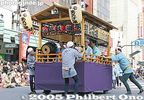
Sadly, the Tokyo Jidai Matsuri is no longer held. It was held annually on Nov. 3 (Culture Day) in Asakusa, Tokyo from 1988 to 2013.The festival was discontinued due to a money scandal by Taito Ward. Tokyo Jidai Matsuri (Festival of Historical Periods) was a parade tracing the history of Tokyo with over 1,600 people dressed in the respective period's costume. This is the lead float playing music. It took about an hour for the parade to reach Kaminarimon Gate.
Lead Float: Edo festival music played by children. Kodomo Edo-bayashi yatai
先導 子供江戸囃子屋台
|
|

This page is a complete English guide to all the groups that appear in the parade. The parade assembles behind Sensoji Temple and starts at 1:30 pm from Nitenmon gate. The procession then goes down Umamichi-dori street, passes by Matsuya Department Store.先導 子供江戸囃子屋台
|
|

From Matsuya Department Store, the procession turns right into Kaminarimon-dori street which passes in front of the famous, giant red lantern called Kaminarimon Gate. Lead float with Edo festival music played by children. 先導 子供江戸囃子屋台
|
|

Lead float with Edo festival music played by children. The names of the children playing are written on the red lanterns hanging above. Kodomo Edo-bayashi yatai 先導 子供江戸囃子屋台
|
|
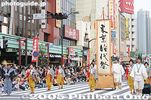
Tokyo Jidai Matsuri Banner and Tekomai geisha. From top to bottom, the banner reads, "Tokyo Jidai Matsuri." It marks the official and real start of the festival parade. The first Tokyo Jidai Matsuri was held in 1989. 東京時代祭本旗The first Tokyo Jidai Matsuri was held in 1989. Slight changes in the festival have been made since. Instead of two oiran courtesans, there is only one now. And at the end of the parade, the Asakusa Revue of showgirls used to be the anchor. But they are now gone.
東京時代祭本旗、手古舞
|
|
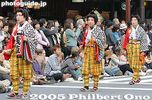
Tekomai geisha existed since the Edo Period. They served as side entertainment at festivals. They only sing traditional chant-like songs called kiyari originally sung by lumberers hauling wood. 手古舞These tekomai did not sing, so they might not be real. When they sing, they hold a fan to their mouth.
手古舞
|
|

Tekomai geisha costume is partially masculine with trousers instead of skirts. Their right shoulder is "exposed" showing a flower design. They carry a red paper lantern imprinted with their names and use their right hand to drag a wand."Asakusa" is written on her lantern. 手古舞
|
|

Tekomai geisha
|
|
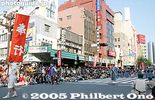
Magistrate Procession 奉行
|
|

A magistrate (bugyo) in Edo could be a regional governor or government minister.
|
|

Magistrate Procession 奉行
|
|
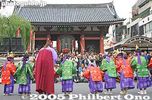
Magistrate Procession. Bowing to Asakusa Temple.
|
|

Year 628: Two fishermen brothers find a golden Kannon buddha statue in Sumida River. The two fishermen were Hinokuma no Hamanari and Takenari. A wealthy landowner named Hajinomatsuchi heard about the statue and told the brothers about its religious value.He then built a small temple for the statue and the brothers converted to Buddhism. The temple eventually became today's Sensoji Temple (also called Asakusa Kannon Temple). Because of the temple, Asakusa developed and prospered and the two brothers and landlord are considered to be the founders of Asakusa.
Next to Sensoji Temple is Asakusa Shrine dedicated to these three men now deified. Asakusa Shrine holds the annual Sanja Matsuri in May, one of Tokyo's biggest festivals. Three portable shrines dedicated to these three men are carried around the streets of Asakusa. "Sanja" means three shrines or gods.
檜前浜成(ひのくまのはまなり)・竹成(たけなり)の兄弟の網に一体の小さなご仏像がかかりました。
東京のあけぼの 浅草観音示現
|
|
|
|
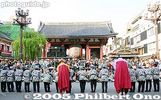
Golden Dragon Dance. 浅草のよろこび 金龍の舞
|
|

According to legend, three days after the golden Kannon statue was found, a golden dragon descended from heaven and danced. The mountain name of the temple is Kinryu-zan, meaning Golden Dragon Mountain. (Most temples have a mountain name.)
|
|
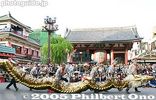
Golden Dragon Dance was first performed in 1958 to commemorate the reconstruction of Sensoji's main worship hall. 浅草のよろこび 金龍の舞
|
|
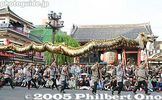
Golden Dragon Dance. No smoke or fire came out of the mouth. The dragon is 15 meters long, weighing about 80 kg. It has a bamboo frame, covered with cloth. Eight men use poles to manipulate the golden dragon.
|
|

Golden Dragon Dance
|
|

Golden Dragon Dance
|
|
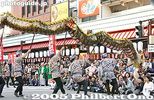
Golden Dragon Dance
|
|

Golden Dragon Dance musicians
|
|
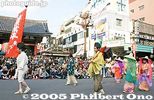
Ariwara no Narihira (825-880) comes to east Japan 在原業平 東下り
|
|

Ariwara no Narihira (825-880) comes to east Japan在原業平 東下り
|
|

Ariwara no Narihira (825-880) comes to east Japan. He was a Japanese waka poet and aristocrat. He was one of six waka poets referred in the preface in kana to Kokinshu by Ki no Tsurayuki. A woman portrays him. 在原業平 東下り
|
|

在原業平 東下り
|
|

在原業平 東下り
|
|

Forces of Minamoto no Yoritomo (1147-1199), the founder and the 1st shogun of the Kamakura Period, who ruled from 1192 until 1199. He is said to have prayed at Asakusa Temple for victory over the Taira Clan to become shogun. 源頼朝 隅田川陣営源 頼朝 隅田川陣営
|
|

Minamoto no Yoritomo (Hatakeyama Shigetada). His prayers for victory were answered. 源 頼朝 隅田川陣営 (畠山重忠)
|
|
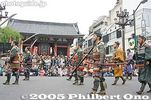
Minamoto no Yoritomo 源 頼朝 隅田川陣営
|
|

Hojo Masako (1156-1225), wife of Minamoto no Yoritomo, worships at Asakusa Temple. As the wife of the first shogun and mother of the second and third shoguns, she was a powerful lady. 北条政子 浅草寺参拝
|
|

Hojo Masako worships at Asakusa Temple. 北条政子 浅草寺参拝
|
|

Warrior monk procession 僧兵行列
|
|

Hojo Masako worships at Asakusa Temple
|
|

It is unusual or unique to see such a procession for Setsubun. 僧兵行列
|
|
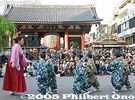
Tokyo Jidai Matsuri 三社大権現祭礼 船渡御
|
|

In 1951 when they were rebuilding the temple destroyed by the war, they found some items which were supposedly used by a warrior monk. 僧兵行列
|
|

White Heron Dance, called Shirasagi no Mai, was revived in 1968 by the Asakusa tourist federation. Originating from the Heian Era, the dance was depicted in a picture scroll owned by the Sensoji Temple. 白鷺の舞It shows the dance being performed for peace when the temple completed a major renovation.
The dance troupe consists of 3 warriors, 1 baton twirler, 1 feeder, 1 grand-umbrella holder, 8 white herons, 19 musicians and guardian children in traditional costumes of the Heian Period.
It is one of the highlights of the festival. It is also performed on other occasions in Asakusa.
白鷺の舞
三社大権現祭礼 船渡御
|
|

So from 1953, as part of the Setsubun ceremonies on Feb. 3, they started this procession of people dressed as warrior monks.
|
|
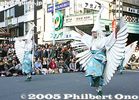
The scroll showed the White Heron Dance being performed for peace when the temple completed a major renovation. 白鷺の舞
It is one of the highlights of the festival. It is also performed on other occasions in Asakusa.
白鷺の舞
三社大権現祭礼 船渡御
|
|

They are not real warrior monks. Monks do not go to battle as they once did centuries ago. Also see the video at YouTube. 僧兵行列
|
|

This White Heron Dance troupe consists of 3 warriors, 1 baton twirler, 1 feeder, 1 grand-umbrella holder, 8 white herons, 19 musicians and guardian children in traditional costumes of the Heian Period.
|
|

Rear view
|
|

White Heron Dance is one of the highlights of the festival. It is also performed on other occasions in Asakusa. The dance was revived in 1968 in Asakusa to mark the Meiji Period Centennial. It has been performed annually on Nov. 3 ever since. 白鷺の舞
|
|

Warrior monks entering Hosenji temple. 僧兵行列
|
|

White Heron Dance, Shirasagi no Mai. The eight white herons represent four male and four female herons.
|
|

This man must be the leader.
|
|

White Heron Dance rear view
|
|

Blowing a conch shell. One of the signals of battle.
|
|
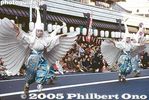
The White Heron Dance originated in Kyoto over 1,100 years ago to purge the city of an epidemic.
|
|

The warrior monk costume is interesting. The collar makes them look bigger and more fearsome. 僧兵行列
|
|
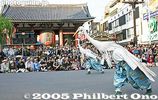
White Heron Dance in front of Kaminarimon Gate.
|
|

The procession started at 3:30 pm at a nearby shrine.
|
|
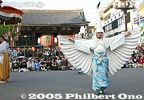
White Heron Dance
|
|

They arrived Hosenji at around 4 pm.
|
|

White Heron Dance
|
|
|

Sarutahiko, Guardian of the earth. 猿田彦 三社大権現祭礼 船渡御
|
|

Memorial service 柴燈大護摩供
|
|
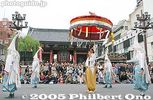
White Heron Dance
|
|
|

Binzasara Dance from Asakusa Shrine. This dance also originated in Asakusa by farmers who celebrated the completion of a tea house in Asakusa near the Asakusa Sensoji Temple. It is now a dance to celebrate a good harvest. びんざさら舞
びんざさら舞
三社大権現祭礼 船渡御
|
|
|

The Binzasara is a musical instrument made of 108 strips of white cedar wood strung together at the top. It is held on both ends and shaken in a wave motion to make a sharp wood clapping sound. It is also accompanied by drums as seen here.びんざさら舞
三社大権現祭礼 船渡御
|
|
|

Binzasara Dance三社大権現祭礼 船渡御
|
|

Instrument players
|
|

Binzasara Dance from Asakusa Shrine. They also throw confetti during the dance.This dance also originated in Asakusa by farmers who celebrated the completion of a tea house in Asakusa near the Asakusa Sensoji Temple. It is now a dance to celebrate a good harvest.
The Binzasara is a musical instrument made of small pieces of white cedar wood strung together at the top. It is held on both ends and shaken in a wave motion to make a sharp wood clapping sound.
びんざさら舞
三社大権現祭礼 船渡御
|
|
|

Shrine maiden and Kaminarimon Gate in Asakusa三社大権現祭礼 船渡御
|
|

柴燈大護摩供
|
|

Sanja portable shrines on boats. Sanja means "Three Shrines." The three fishermen who found the Kannon buddha statue (the origin of Sensoji Temple) are deified by Asakusa Shrine next to Sensoji Temple. 三社大権現祭礼 船渡御This is the first portable shrine. The portable shrines used to be paraded in a boat.
三社大権現祭礼 船渡御
|
|

Setting afire
|
|
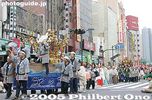
Asakusa Shrine holds the annual Sanja Matsuri in May, one of Tokyo's biggest festivals. Three portable shrines dedicated to these three fishermen are carried around the streets of Asakusa. "Sanja" means three shrines or gods. Portable shrineSecond and third portable shrines.
三社大権現祭礼 船渡御
|
|

柴燈大護摩供
|
|
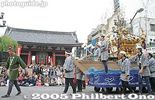
Second portable shrine. 三社大権現祭礼 船渡御
|
|
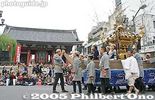
Third portable shrine. 三社大権現祭礼 船渡御
|
|
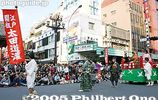
Year 1457: Ota Dokan, initial builder of Edo Castle. 江戸開祖 太田道灌、従者・山吹娘
|
|
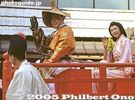
Ota Dokan, initial builder of Edo Castle. This is played by Shun'ichi Suzuki, the then governor of Tokyo. Body guards were around his float. He is dressed in a hunter's costume. Behind him is an attendant named Yamabuki.江戸開祖 太田道灌、従者・山吹娘
|
|

1608: Ieyasu orders Edo Castle expansion: Rock-hauling procession. Big boulders were hauled from Izu Peninsula's east coast. 江戸城築城 お石曵き
|
|

Edo Castle construction: Rock-hauling procession. 江戸城築城 お石曵き
|
|

Edo Castle construction: Rock-hauling procession江戸城築城 お石曵き
|
|
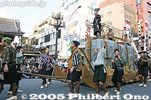
Edo Castle construction: Rock-hauling procession. Not a real boulder.
|
|

Year 1590: Tokugawa Ieyasu takes up residence in Edo. His procession. 徳川家康 江戸入府
|
|

Tokugawa Ieyasu takes up residence in Edo. 徳川家康 江戸入府
|
|

Lord Ii Naomasa, a right-hand man of Tokugawa Ieyasu and major ally in the Battle of Sekigahara in 1600. Based in Hikone, Shiga Prefecture. 井伊直政 徳川家康 江戸入府
|
|

Year 1603: Tokugawa Ieyasu becomes Shogun. He designates Asakusa Temple as a place of worship, and he worships there himself in 1616. Behind him is his son Tokugawa Hidetada who became the second Tokugawa shogun. 徳川家康 江戸入府
|
|

Tokugawa Ieyasu takes up residence in Edo and founds the Tokugawa or Edo Period that lasted until 1868.徳川家康 江戸入府
|
|

Inner palace women. 大奥御殿女中
|
|

Inner palace women 大奥御殿女中
|
|
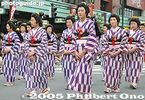
Inner palace women
|
|

Inner palace women
|
|
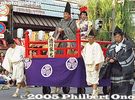
1649: Tokugawa Iemitsu. In 1649 during his reign as shogun, Asakusa Shrine was built. 徳川家光 三社権現社再建寄進
|
|
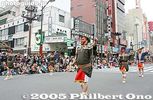
1635: Sankin Kotai Daimyo Gyoretsu. The daimyo was a warlord who owned and supervised a fief. Tokugawa Iemitsu started the Sankin kotai system where all daimyo were required to visit Edo annually at great expense. 参勤交代 大名行列The daimyo was a warlord who owned and supervised a fief. Tokugawa Iemitsu started the Sankin kotai system where all daimyo were required to visit Edo annually at great expense since they traveled in a large contingent.
参勤交代 大名行列
|
|
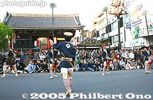
Sankin Kotai Daimyo Gyoretsu. "Gyoretsu" means procession. It was a great expense since they traveled in a large contingent. 参勤交代 大名行列
|
|

Sankin Kotai Daimyo Gyoretsu 参勤交代 大名行列
|
|

Sankin Kotai Daimyo Gyoretsu in front of Kaminarimon Gate.参勤交代 大名行列
|
|

Sankin Kotai Daimyo Gyoretsu参勤交代 大名行列
|
|

Sankin Kotai Daimyo Gyoretsu参勤交代 大名行列
|
|

Sankin Kotai Daimyo Gyoretsu palanquin. This is how the daimyo traveled--in a comfortable box hand-carried by men. 参勤交代 大名行列
|
|
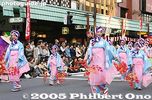
Genroku Flower-Viewing Dance. The Genroku Period was 1688-1704, a time of cultural flowering among the masses. 元禄花見踊り
|
|

Genroku Flower-Viewing Dance 元禄花見踊り
|
|

Genroku Flower-Viewing Dance
|
|

Year 1702: The 47 masterless retainers arrive to avenge their lord. In 1701 in the shogun's palace, Lord Asano Naganori draws his sword in a fit of anger and cuts Kira Yoshinaka, the highest-ranking master of protocol who had mocked Asano.Asano was immediately forced to commit ritual seppuku. At the end of the following year, his 47 masterless retainers avenged their master's death by attacking and beheading Kira at his residence in Ryogoku. This story of loyalty soon becomes a timeless classic known as "Chushingura."
義士の討ち入り
|
|
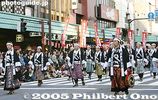
On Dec. 14, 1702, Asano's 47 masterless retainers avenged their master's death by attacking and beheading Kira at his residence in Ryogoku.義士の討ち入り
|
|

This story of loyalty soon becomes a timeless classic known as "Chushingura." 義士の討ち入り
|
|

1717: Firemen's Acrobatics. Ooka Echizen no Kami Tadasuke (1677-1751) and Edo Fire Brigade. Ooka was a famous Edo magistrate who organized fire brigades in Edo. 大岡越前守と江戸町火消
|
|

Firemen's Acrobatics 大岡越前守と江戸町火消
|
|

Firemen's Acrobatics大岡越前守と江戸町火消
|
|

Firemen's Acrobatics大岡越前守と江戸町火消
|
|
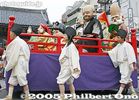
Seven Gods of Good Fortune 浅草市村座七福神舞浅草市村座七福神舞
|
|
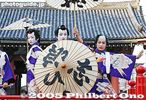
1624: Saruwaka Sanza, Edo Kabuki. Kabuki was started in the early Edo Period in 1624. Later, Edo's three licensed kabuki theaters named the Nakamura-za, Ichimura-za, and Morita-za were relocated to Asakusa in an area called Saruwaka."Sanza" means three theaters. 猿若三座 江戸歌舞伎
|
|
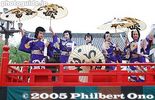
Saruwaka Sanza, Edo Kabuki. "Sanza" means three theaters. 猿若三座 江戸歌舞伎猿若三座 江戸歌舞伎
|
|

Saruwaka Sanza, Edo Kabuki猿若三座 江戸歌舞伎
|
|
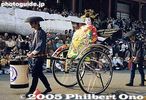
Oiran Dochu Procession. This picture was taken next to the Sensoji Temple behind which the parade starts. Before, one oiran courtesan rode in a rickshaw. 花の吉原おいらん道中花の吉原おいらん道中
|
|
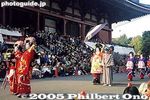
Oiran Dochu Procession 花の吉原おいらん道中
|
|

Oiran Dochu Procession. Passing by Matsuya Dept. Store and Tobu Asakusa Station.
|
|
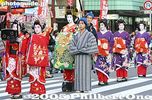
Oiran Dochu Procession. This is definitely the highlight of the festival, and my favorite part of the festival. 花の吉原おいらん道中
|
|

Oiran Dochu Procession. The two little girls are called kamuro.
|
|

Oiran Dochu Procession
|
|

The oiran courtesan is escorted by two little girls called kamuro. 花の吉原おいらん道中
|
|

Oiran Dochu Procession花の吉原おいらん道中
|
|
|

She walks in a very slow and stylized way, her feet taking figure-8 steps. She needs the man's shoulder to steady herself.
|
|
|

Oiran Dochu Procession in front of Kaminarimon Gate, Asakusa.花の吉原おいらん道中
|
|

Oiran Dochu Procession花の吉原おいらん道中
|
|

Oiran Dochu Procession. Her clogs. 花の吉原おいらん道中
|
|
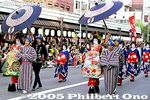
Oiran Dochu Procession. This picture was taken in the 1990s when they had two oiran in the festival. Now they have only one. 花の吉原おいらん道中
|
|
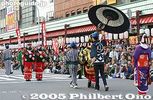
Oiran Dochu Procession花の吉原おいらん道中
|
|

Oiran Dochu Procession花の吉原おいらん道中
|
|
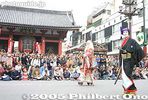
Hanakawa do Sukeroku & Ikyu (kabuki characters). Sukeroku and Ikyu vie for the love of a courtesan named Agemaki. 花川戸助六 意休
|
|

Hanakawa do Sukeroku, a favorite son of Asakusa and famed womanizer. He was loved by the people since he sided with the weak and defeated the strong. Made into a kabuki character. 花川戸助六 意休
|
|

Ikyu, the villain. 花川戸助六 意休
|
|
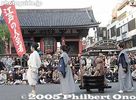
Edo's Popular People 江戸の人気者江戸の人気者
|
|
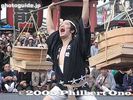
Edo's Popular People--Isshin Tasuke, a fish peddler and a very popular fictional character. 江戸の人気者(一新太助)
|
|
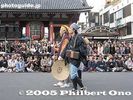
Edo's Popular People: Mito Komon, an important lord related to the Tokugawa Shogun. He was based in Mito, Ibaraki Pref. Most people know him through the popular Mito Komon TV series. Most people know him through the popular Mito Komon TV series where he is shown traveling around incognito to help people being oppressed by corrupt officials, etc. When he reveals his real identity to the villains, they instantly go down on their knees and maybe even poop in their pants.
江戸の人気者
|
|
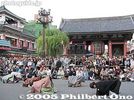
Mito Komon: He travels around incognito to help people being oppressed by corrupt officials, etc. When he reveals his real identity to the villains, they instantly go down on their knees and maybe even poop in their pants.Bowing to Mito Komon.
江戸の人気者
|
|

Edo Geisha. These geisha are from Asakusa, which also happens to be one of Tokyo's geisha districts. 江戸芸者
|
|

Edo Geisha江戸芸者
|
|

Edo Geisha 江戸芸者江戸芸者
|
|

Edo Geisha江戸芸者
|
|

Edo Geisha, She was the only one with a smile.
|
|

Edo Geisha江戸芸者
|
|

Edo Geisha江戸芸者
|
|

Edo Geisha江戸芸者
|
|
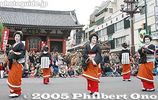
Edo Geisha portrayed by Asakusa geisha.江戸芸者
|
|
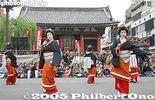
Edo Geisha江戸芸者
|
|

Edo Geisha江戸芸者
|
|

This was the only one who had a smile. The others were quite serious and solemn.
|
|

Edo Geisha江戸芸者
|
|

Edo Geisha江戸芸者
|
|

Arrival of Black Ships 黒船来航・浦賀奉行黒船来航・浦賀奉行
|
|
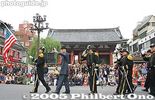
Townsend Harris and Commodore Perry, played by Americans from Yokosuka Naval Base. 黒船来航・浦賀奉行
|
|

Townsend Harris and Commodore Perry 黒船来航・浦賀奉行
|
|

Mistress Okichi, the infamous mistress of Townsend Harris, America's first ambassador to Japan when he was in Shimoda. Another mistress was provided to Harris' interpreter.Okichi was the infamous mistress of Townsend Harris, America's first ambassador to Japan. Another mistress was provided to Harris' interpreter.
黒船来航・浦賀奉行
|
|
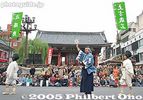
Shinsengumi was a Kyoto-based, pro-shogunate group of skilled swordsmen of Edo and masterless samurai in Kyoto formed to suppress the growing opposition (especially from Choshu) against the shogunate in favor of restoring the Emperor to power. 新撰組The group disbanded when the shogunate collapsed and Emperor Meiji became the head of state. 新撰組
|
|

Shinsengumi disbanded when the shogunate collapsed and Emperor Meiji became the head of state. The Shinsegumi wore a distinct costume with a light blue haori. 新撰組
|
|

Shinsengumi新撰組
|
|
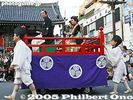
Year 1867: Tokugawa Yoshinobu, the 15th and last shogun who surrendered power to the emperor and fled Edo in 1868 following military defeat by powerful provincial lords seeking to return power to the Emperor. 第十五代将軍 徳川慶喜第十五代将軍 徳川慶喜
|
|

1868: Transition from Edo to Tokyo (Saigo Takamori). With the Meiji Restoration in 1868, the ruler of Japan shifts from the shogun to an oligarchy ruling under the banner of the emperor. Edo is renamed Tokyo. 江戸から東京へWith the Meiji Restoration in 1868, the ruler of Japan shifts from the shogun to an oligarchy ruling under the banner of the emperor. Edo is renamed as "Tokyo (Tokio)," meaning "Eastern Capital," as ordered by Emperor Meiji.
江戸から東京へ
|
|
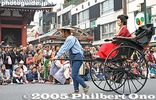
Cultural enlightenment: Higuchi Ichiyo (1872-96) was a critically-acclaimed novelist who also graces the 5,000 yen bill. At age 24, she died of tuberculosis. 文明開化 樋口一葉
|
|

Asakusa Folk Entertainment. Behind the Asakusa Temple, there was a variety of shows, street performers, plays, and other characters. Asakusa has always been Tokyo's entertainment center. 浅草奥山風景
|
|
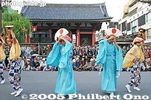
Asakusa Folk Entertainment 浅草奥山風景
|
|
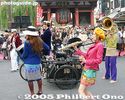
Asakusa Folk Entertainment. This was the last act. Somewhat tacky end to the festival.
|
|

Sign near Bannaji temple saying that the warrior procession would start at 7 pm.
|
|

On the way to Bannaji temple, this statue of the Ashikaga lord.
|
|

Gate to Bannaji temple. It is actually an arched bridge.
|
|

Gate to Bannaji temple.
|
|

Behind the gate to Bannaji temple.
|
|

After going through the gate, there's this path to the temple hall. Now lined with food stalls during the festival.
|
|

Plum trees
|
|

Bannaji temple main hall. National Treasure built by Ashikaga Takauji's father. A rare example of a main temple hall from the Kamakura Period.
|
|

Carrying wooden boxes of beans.
|
|

At one point along the procession route (a major road), there was a rest station where they served free ama-zake (sweet sake). The hot drink warmed us up.
|
|

On Feb. 3, the Yoroi Toshikoshi Shuko festival is held in the evening with a warrior procession going to Bannaji. Start of the warrior procession consisting of local children, men, and women. The procession started at Orihime Kominkan. 織姫公民館
|
|

Since it is held at night in the middle of winter, dress warmly.
|
|
|

Going over the arched bridge at Bannaji temple.
|
|
|
|
|
|
|
|
|

Yoroi Toshikoshi Shuko festival, Ashikaga, Tochigi.
|
|
|
|

Once in a while, they would shout a war cry.
|
|
|
|
|
|
|
|

Yoroi Toshikoshi Shuko festival, Ashikaga, Tochigi.
|
|
|
|
|
|
|
|
|
|
|
|
|
|
|

I saw at least two foreigners also dressed up as well.
|
|
|
|
|
|

Yoroi Toshikoshi Shuko festival, Ashikaga, Tochigi.
|
|

They all entered Bannaji temple by crossing the narrow arched bridge.
|
|
|
|
|
|
|

Within the grounds of Bannaji temple, they all gathered at this small outdoor stage.
|
|

After a few speeches, they got boxes of beans and threw them at us, but only the people up front got hit with beans.
|
|

The bean throwing was very short, both time-wise and distance-wise.
|
|
|
|
|
|

The bean-throwing was disappointing at Yoroi Toshikoshi Shuko festival in Ashikaga, Tochigi. Few beans and they hardly reached anybody.
|
|

Japan's oldest school.
|
|
|

Adjacent to the Dotaku Museum is a replica of a Yayoi Period village. Yayoi Period (500 BC to 300 AD) is noted as when rice growing started in Japan.
|
|

These ancient abode were pretty much a hole in the ground with a roof over it.
|
|
|
|
|
|

Inside a Yayoi-Period grass shack.
|
|
|
|
|
|

The ceiling has square beams.
|
|
|

Some pots inside a hut.
|
|

It would be a matter of time before walls were constructed below the roof.
|
|
|
|
|

This elevated structure served as a storehouse.
|
|
|
|
|
|
|
|

From JR Yasu Station's South exit (Minami-guchi), take a bus going to Karyoku Koen (花緑公園) or Murata Seisakusho (via Nishi Gate 西ゲート経由 村田製作所行き) and get off at Dotaku Hakubutsukan-mae (銅鐸博物館前). Bus ride is
|
|

Yamanokami mountain god monument
|
|

Statue of Lord Ii Naomasa (井伊 直政 1561-1602 ) in front of JR Hikone Station in 2007.
|
|
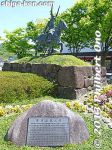
Statue of Lord Ii Naomasa (井伊 直政 1561-1602 ) in front of JR Hikone Station. One of the four great generals (徳川四天王) who helped Tokugawa Ieyasu win the Battle of Sekigahara (関ヶ原合戦) in 1600 to unify Japan and become shogun.
|
|
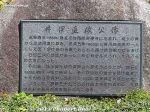
Ieyasu rewarded Naomasa with the strategic domain of Hikone (mainly Hikone, Maibara, Nagahama, Taga), making Naomasa the first Hikone daimyo (feudal lord 大名) in Omi Province (近江国).
|
|
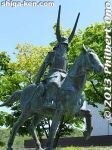
Sawayama Castle (佐和山城) came with the domain, but Naomasa did not like it, being outdated and the former castle of Ishida Mitsunari (石田 三成) who lost at Sekigahara.
|
|
| 812 files on 4 page(s) |
1 |
 |
|